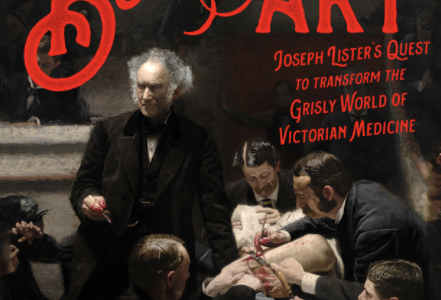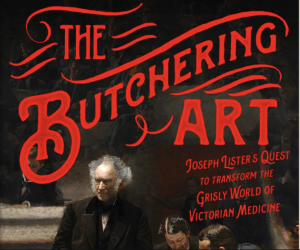
Advances in germ theory and transformation of Victorian medicine
 Medical historian, Lindsey Fitzharris tells a gripping tale of scientific and medical exertion, including the oozing pus and rotting flesh that followed infections in the days before antiseptics. In the past the idea of doctors washing hands before touching them into an open wound would have been considered a waste of his time, until Lister’s promotion of antiseptics and sterilisation as a means of preventing post-operative gangrene.
Medical historian, Lindsey Fitzharris tells a gripping tale of scientific and medical exertion, including the oozing pus and rotting flesh that followed infections in the days before antiseptics. In the past the idea of doctors washing hands before touching them into an open wound would have been considered a waste of his time, until Lister’s promotion of antiseptics and sterilisation as a means of preventing post-operative gangrene.
Fitzharris, reveals the shocking world of nineteenth century surgery, goes back to 1846 with the first operation in Britain using anaesthetic : a leg amputation performed by Dr Robert Liston, renowned for his speed and brute strength, and how he persevered in unsanitary and Although a patient could be made unconscious during an operation was a huge breakthrough, but it did not solve the critical problem of infected wounds leading to agonising death. Surviving an operation was only the first hurdle towards recovery. In mid-19 century there were two theories of infection, one brought in by via imported goods from pestilent regions of the world for which the solution was quarantine and trade restrictions and the other disease was carried via vapours, gases, noxious smells and maisma and the solution was environmental improvements.
Fitzharris meticulously reconstructs Lister’s career path to his audacious claim that germs were the source of all infection and could be encountered by a sterilizing agent applied to wounds, and describes the life in the squalid hospitals, grimy schools and industrial cities makes clear, germ harbouring dirt and wastes were permanent feature of everyday life. Lister, a young melancholy Quaker and a medical student in the 1840s, knew the stench and horror of London, burial pits heaving with thousands of decomposing bodies, the putrid slime of the local church yard at Clement’s Lane in the East End.
From Smithfield market men carried on their clothes the ordure of their unholy profession back to the slums in which they lived. Revolting stinking gases and liquids poured from the cadaver’s stomach on to a sawdust where rats nibbled bits of human vertebrae.
Lister’s father was a wine merchant with a fascination for optics that earned him a fellowship of the Royal Society, and Lister’s use of the microscope was central to his work on antiseptics. Under Dr John Erichsen, Lister started his surgical career at the University College, who once clamped his mouth to the open neck wound of a patient, asphyxiating from blood in the lungs and sucked out the liquid and mucus.
Building on Louis Pasteur’s discoveries about microbes, Lister applied antiseptic directly to a wound to prevent infection without damaging the surrounding tissue and this deed changed the culture and hygiene of medicine, hospitals and surgery forever. He also observed that carbolic acid (coal tar) used by sewage workers to counter act the smell in fields irrigated with liquid waste, and developed a carbolic spray that proved successful in post-operative healing and thus ensured that the odour of disinfectant and sanitation would be the sweet smell of coal tar.
Inspired by his lecture at Philadelphia, three Johnson brothers established a sterile surgical dressings company. In 1879, Dr Joseph Lawrence created a phenol- and eucalyptus mouthwash called Listerine.
The Butchering Art celebrated the triumph of a visionary surgeon who pursuit to unite science and medicine delivered us into the modern world.
The Butchering Art: Joseph Lister’s Quest to Transform the Grisly World of Victorian Medicine by Lindsey Fitzharris, Allen Lane £ 16.99 /Farrar, Straus & Girous $27, 304 pages.
